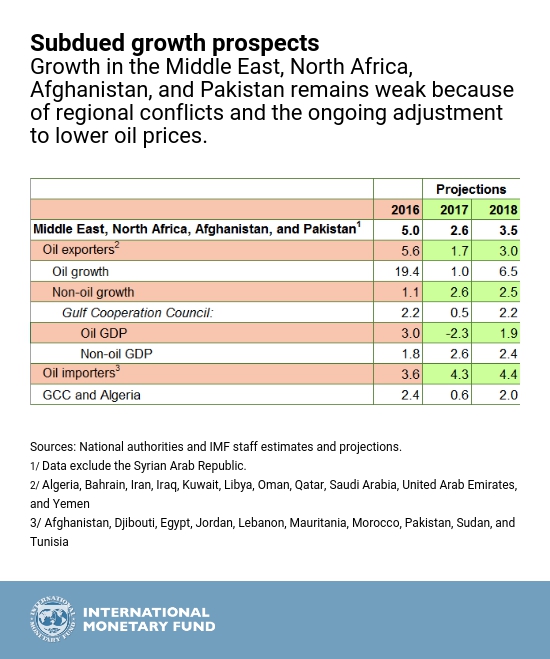
Middle East, North Africa, Afghanistan, and Pakistan: Take Advantage of Strengthening Global Economy
October 31, 2017
The economic prospects of the Middle East, North Africa, Afghanistan, and Pakistan (MENAP) region remain subdued primarily because of the ongoing adjustment to low oil prices and regional conflicts, observes the IMF in its latest Regional Economic Outlook. Countries in the region should capitalize on the current global growth upswing to place their public finances on a sounder footing, accelerate job-creating reforms, and diversify their economies.
Related Links
Oil exporters: lower growth, stubborn budget deficits
Overall growth in oil exporters is expected to bottom out at 1.7 percent in 2017, driven by lower oil output under the Organization of Petroleum Exporting Countries (OPEC)-led agreement. In contrast, non-oil growth is expected to recover to about 2.6 percent in 2017 as the pace of budget deficit reduction slows.

Despite the progress already made, low oil prices have kept the fiscal deficits large in many oil exporters, highlighting the need for a continued focus on deficit reduction. Budget deficits of oil exporters jumped to 10.6 percent of GDP in 2016 from 1.1 percent of GDP in 2014. These are expected to halve this year due to a modest recovery in oil prices and significant deficit reduction efforts. But since oil prices are expected to remain in the range of $50-60 a barrel, oil exporters will need to sustain—and in some cases intensify—their budget deficit-reduction efforts.
Oil importers: faster growth, high public debt
Growth in oil importers is projected to rise to 4.3 percent this year from 3.6 percent in 2016. The upswing is expected to persist in 2018, supported by increasing domestic demand, supportive reforms, and the global uptick in growth.
On the fiscal front, many oil importers continue to struggle with insufficient revenue mobilization on one hand, and higher current expenditures (including public wage bills) on the other hand. This has pushed public debt to more than 50 percent of GDP in most countries. Countries should focus on improving revenue collection and targeted spending cuts, while protecting social and growth-enhancing spending.
Good time to pursue reforms
All MENAP countries should take advantage of the window of opportunity provided by the strengthening global economy to implement job-creating reforms.
These countries need such reforms to tackle their already high unemployment and to absorb the over 26 million young people expected to enter the labor force by 2022. Governments can play an important role in boosting the private sector by improving the business environment, transparency and accountability of public institutions, and access to finance. Enhancing education to better match workers’ skills needs and encouraging freer movement of labor are also important. At the same time, social safety nets should be maintained to safeguard the vulnerable in society.
In the current climate of strengthening global recovery, countries should also take advantage of international trade to support their economic growth. Oil importers are already better integrated into the global value chains and have more diversified export bases. They should, therefore, focus on improving the quality of their exports. Oil exporters, in turn, need to diversify their production to be able to export a broader range of goods and services. Most countries would benefit from trade agreements and new integration opportunities, such as China’s Belt and Road Initiative and the Compact with Africa.









